
| ||||
|---|---|---|---|---|
 |
 |
 |
 |
 |



























| ||||
|---|---|---|---|---|
 |
 |
 |
 |
 |


























Globe GC-1B Swift
Single-engine two-seat sport monoplane, USA
Archive Photos
Globe GC-1B Swift (N78103) at the 2006 Camarillo Air Show, Camarillo, California (Photos by John Shupek)
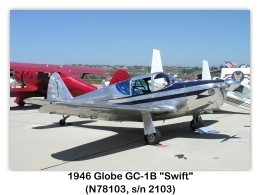
Globe GC-1B Swift (N3214K, s/n 1207, 1946) at the 2006 Cable Airshow, Cable Airport, Upland, California (Photos by John Shupek)
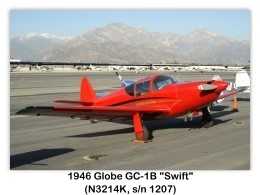
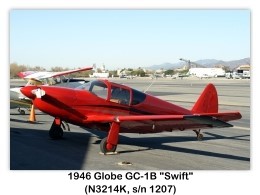
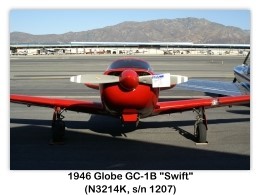
Globe GC-1B Swift (N3378K) at the 2006 Cable Airshow, Cable Airport, Upland, California (Photos by John Shupek)

Globe GC-1B Swift (N3214K, s/n 1207, 1946) at the 2009 Cable Airshow, Cable Airport, Upland, California (Photos by John Shupek)





Globe GC-1B Swift-Miss Texas (N78238) at the 2007 Camarillo Air Show, Camarillo, California (Photos by John Shupek)
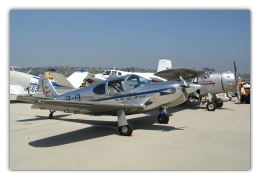
Overview 2,3
The Globe Aircraft Corporation was originally formed as the Bennett Aircraft Corporation to manufacture aircraft employing the use of Duraloid, a phenol-formaldehyde Bakelite-bonded plywood. In 1941 the Company was reorganized and the name was changed to Globe Aircraft Corporation. The first product of the re-constituted company was a small two-seat low-wing cabin monoplane known as the Swift. The Swift Model GC-1 was awarded an Approved Type Certificate in the Spring of 1942 but it never went into production owing to the restriction of materials.
In 1942 a license agreement was concluded between the Beech Aircraft Corp. and the Globe Aircraft Corp. under which the latter undertook to manufacture 600 Beechcraft AT-10 Twin-engine training monoplanes for the U.S. Army Air Forces. This contract was completed in 1944 and to replace it the company undertook sub-contract work for the Curtiss C-46 and other aircraft.
In 1946 a new version of the Swift was produced and two models were in production: the GC-1A with an 85-hp Continental four-cylinder horizontally-opposed engine, and the GC-1B with a 125-h.p. Continental six-cylinder engine. Constructionally the two aircraft are identical although the difference in power-unit results in a change in nose shape. The prototype GC-1A made its initial test flights in January, 1945.
A license for the manufacture of the Globe Swift in Great Britain was been acquired by Helliwells, Ltd. of Walsall, Staffs. The British version was known as the Helliwell Globe. The Globe Swift (also known as the Globe/Temco Swift), first advertised as the All Metal Swift , was a light, two-seat sport monoplane of the post-World War II period.
Design and Development
Designed by R.S. Pop Johnson in 1940, the fanciful story of a Culver Cadet obtained as a template aircraft has now entered into popular mythology surrounding the aircraft’s origins. The design was secured by John Kennedy, president of the Globe Medicine Company, to be built by his new Globe Aircraft Company. World War II interrupted their plans, however, and the 85-hp GC-1A Swift advertised as the All Metal Swift re-designed by K.H. Bud Knox, received its type certificate on 7 May 1946. Two prototypes were built but essentially, the design remained the same as the type entered production. Globe built about 408 GC-1A Swift’s.
Later that year, the Swift received a more powerful engine of 125-hp, making it the Globe GC-1B Swift. Globe, together with TEMCO, built 833 Globe GC-1B Swifts in six months. Globe was out pacing sales of the Swift, however, and did not have enough orders to sell all of the aircraft being built. As a result Globe was forced into insolvency. TEMCO being the largest debtor received permission from the receiver to obtain the type certificate, tooling, aircraft, and parts to enable them to continue production in late 1947, in the hope that reviving production would enable TEMCO to recover their loss. TEMCO went on to build 260 more aircraft before shutting Swift production down permanently in 1951.
The type certificate for the Swift was obtained by Universal Aircraft Industries (later Univair) along with all production tooling. Spare parts continued to be built until 1979 when the Swift Association under the leadership of President Charlie Nelson was approached to take over the operation.
Operational History
The Globe/TEMCO Swift has seen many modifications. It began life with an C-85 (85-hp) engine driving a wooden propeller. Within a year the engine was upgraded to a C-125, turning a metal propeller. Performance had been marginal with 85-hp, and only moderate with 125-hp, so many owners have installed more powerful engines, such as 145-hp, 150-hp, 160-hp, 180-hp and even 210-hp. Combined with upgraded cowlings, canopies and propellers, an upgraded Swift can look startlingly modern, and give many of today’s best sport planes a run for their money.
The most unusual variant of the series became a separate design, the TEMCO TE-1 Buckaroo which was built in a short-run first as a contender for a USAF trainer aircraft contract, and later ended up in foreign service as a military trainer. Several of these trainers have since returned to the civil market.
Specifications and Performance Globe GC-1B Swift 3
Type
Wings
Fuselage
Tail Unit
Landing Gear
Power Plant
Accommodation
Dimensions
Weights and Loadings
Performance (at loaded weight)
References